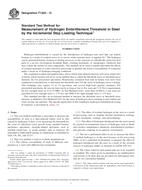Potrebujeme váš súhlas na využitie jednotlivých dát, aby sa vám okrem iného mohli ukazovať informácie týkajúce sa vašich záujmov. Súhlas udelíte kliknutím na tlačidlo „OK“.
ASTM F1624-12
Standard Test Method for Measurement of Hydrogen Embrittlement Threshold in Steel by the Incremental Step Loading Technique
Automaticky preložený názov:
Štandardná skúšobná metóda pre meranie vodíkovej krehkosti prahu z ocele podľa platového stupňa Nakladacia technika
NORMA vydaná dňa 1.8.2012
Informácie o norme:
Označenie normy: ASTM F1624-12
Poznámka: NEPLATNÁ
Dátum vydania normy: 1.8.2012
Kód tovaru: NS-50952
Počet strán: 12
Približná hmotnosť: 36 g (0.08 libier)
Krajina: Americká technická norma
Kategória: Technické normy ASTM
Anotácia textu normy ASTM F1624-12 :
Keywords:
decreasing loading rate, delayed brittle failure, displacement control, fasteners, hydrogen embrittlement threshold, hydrogen induced stress cracking, rising step load, slow strain rate, ICS Number Code 77.040.10 (Mechanical testing of metals)
Doplňujúce informácie
| Significance and Use | ||||||||||||||||||||||||||||||||||
|
5.1 This test method is used for research, design, service evaluation, manufacturing control, and development. This test method quantitatively measures stress parameters that are used in a design or failure analysis that takes into account the effects of environmental exposure including that which occurs during processing, such as plating (8) (ASTM STP 962). 5.2 For plating processes, the value of σ 5.3 For quality control purposes, an accelerated test is devised that uses a specified loading rate, which is equal to or lower than the loading rate necessary to determine the threshold stress (see 8.1). 5.4 For fasteners, the value of σ5.5 For fasteners, the value of σ5.6 To measure the relative susceptibility of steels to hydrogen pickup from various fabrication processes, a single, selected, discriminating rate is used to rank the resistance of various materials to hydrogen embrittlement. 5.7 Annex A1 describes the application of this standard test method to hydrogen embrittlement testing of fasteners. |
||||||||||||||||||||||||||||||||||
| 1. Scope | ||||||||||||||||||||||||||||||||||
|
1.1 This test method establishes a procedure to measure the susceptibility of steel to a time-delayed failure such as that caused by hydrogen. It does so by measuring the threshold for the onset of subcritical crack growth using standard fracture mechanics specimens, irregular-shaped specimens such as notched round bars, or actual product such as fasteners 1.2 This test method is used to evaluate quantitatively: 1.2.1 The relative susceptibility of steels of different composition or a steel with different heat treatments; 1.2.2 The effect of residual hydrogen in the steel as a result of processing, such as melting, thermal mechanical working, surface treatments, coatings, and electroplating; 1.2.3 The effect of hydrogen introduced into the steel caused by external environmental sources of hydrogen, such as fluids and cleaners maintenance chemicals, petrochemical products, and galvanic coupling in an aqueous environment. 1.3 The test is performed either in air, to measure the effect if residual hydrogen is in the steel because of the processing (IHE), or in a controlled environment, to measure the effect of hydrogen introduced into the steel as a result of the external sources of hydrogen (EHE) as detailed in ASTM STP 543. 1.4 The values stated in inch-pound units are to be regarded as standard. The values given in parentheses are mathematical conversions to SI units that are provided for information only and are not considered standard. 1.5 This standard does not
purport to address all of the safety concerns, if any, associated
with its use. It is the responsibility of the user of this standard
to establish appropriate safety and health practices and determine
the applicability of regulatory limitations prior to use.
|
||||||||||||||||||||||||||||||||||
| 2. Referenced Documents | ||||||||||||||||||||||||||||||||||
|




 Cookies
Cookies
